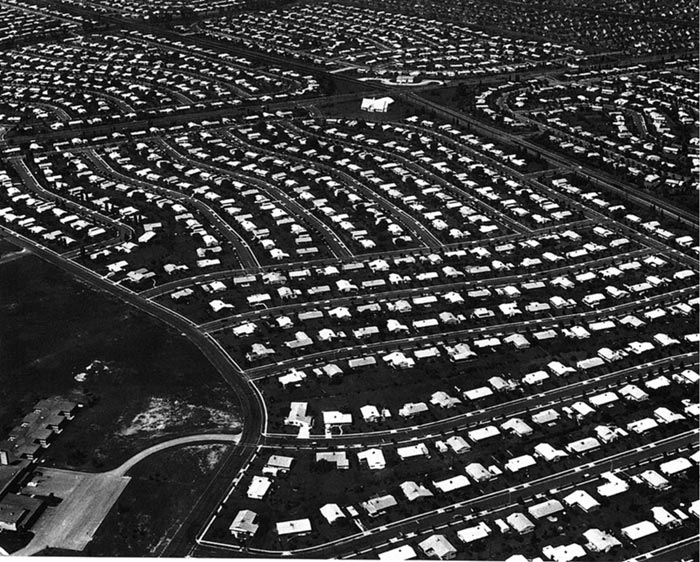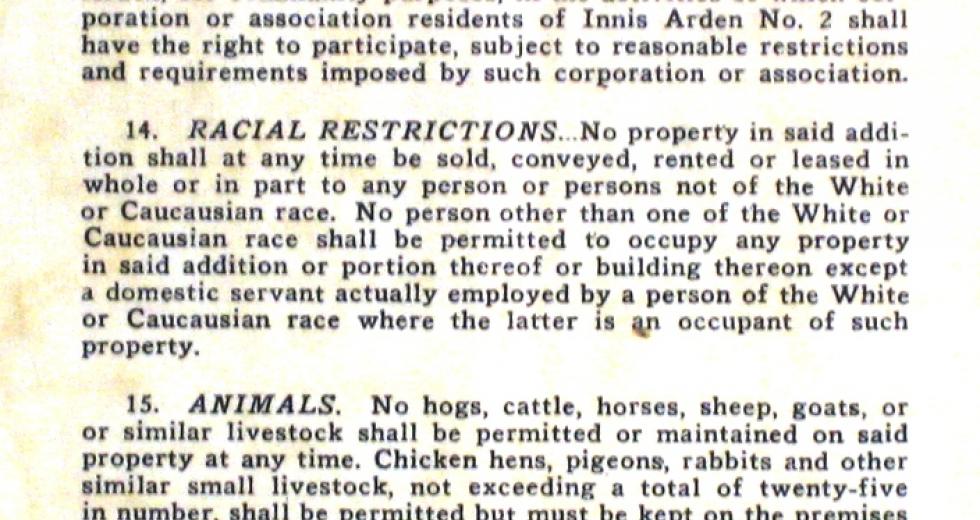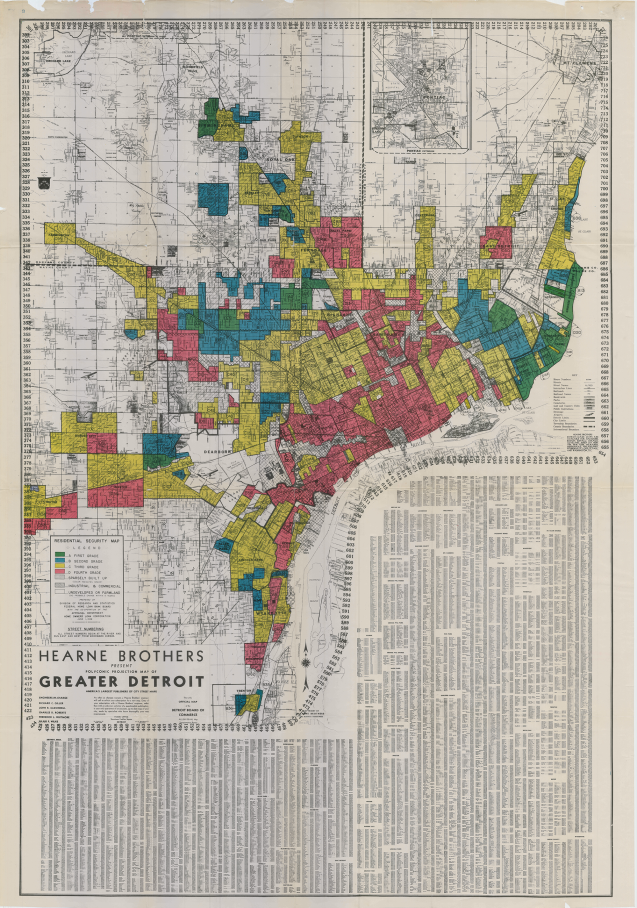

It is often assumed that segregation by race in cities and suburbs (particularly in the north) was and is a result of “natural” processes, even when those processes are the ugly expression of white fear. White flight to the suburbs, the logic goes, may be reprehensible, but it’s a predictable result when white people, guided by prejudice, felt their neighborhoods were in danger of being “taken over.” In reality, that does not accurately describe what happened in urban and suburban areas. The segregation of areas by race was more than a choice made by individuals; it was abetted and reinforced by private and public policies, laws, and regulations. (Note: The following post is, for the most part, about northern cities; southern cities may have followed similar patterns, but I haven’t researched southern cities enough to say that with any certainty.)
Prior to the early 20th century, the migration and settlement patterns in cities followed a predictable path. Most cities had a de facto central “reception area” where immigrants and newly-arrived African-Americans tended to initially cluster. Strict boundaries did not exist, and racially-diverse neighborhoods did exist, most often defined by class or a common workplace, rather than race or ethnic origin. When movement occurred, it was not on the basis of abandoning a “changing neighborhood” as much as it was movement to less-settled areas, where new single-family housing could be built and purchased, houses of worship could be established, and communities could be created. It was at this point in the evolution and growth of cities that places like a “Little Italy” or a “Germantown” came to be recognized neighborhoods. Often, African-Americans were able to make similar moves, despite lower wages and fewer job opportunities. In Detroit, for example, African-Americans moved to the outermost limits of the city, or in un-annexed areas, near Eight Mile and built their own homes.
It was with the Great Migration (starting around 1916 in response to the need for industrial workers in the north and the increasingly violent and oppressive Jim Crow policies of the South), and the increasing availability and importance of the automobile that these long-established housing patterns started to change. By 1919, it is estimated that one million black southerners had migrated to northern cities.
In the decade between 1910 and 1920, the black population of major Northern cities grew by large percentages, including New York (66 percent), Chicago (148 percent), Philadelphia (500 percent) and Detroit (611 percent).
Many new arrivals found jobs in factories, slaughterhouses and foundries, where working conditions were arduous and sometimes dangerous. Female migrants had a harder time finding work, spurring heated competition for domestic labor positions.
Aside from competition for employment, there was also competition for living space in increasingly crowded cities. While segregation was not legalized in the North (as it was in the South), racism and prejudice were nonetheless widespread. Source: Great Migration
Migration within city limits was often one “solution” for fearful whites, but increasingly, white developers, homeowners, and politicians turned to exclusionary tactics.
(bolding mine)
Three exclusionary devices, each of which had been perfected in the two decades preceding World War II, gave postwar American metropolitan areas their racially segregated character. First, private but legally enforceable restrictive covenants – attached to nearly every housing development built between 1920 and 1948 – forbade the use or sale of a property to anyone other than whites. Second, federal housing policies, enacted during the Depression, mandated racial homogeneity in new developments and created a separate, unequal housing market, underwritten with federal dollars, for blacks and whites. Third, real estate agents staunchly defended the “freedom of association” and the right of home owners and developers to rent or sell to whom they pleased, steering blacks into racially mixed of all-black neighborhoods. Source: Sweet Land of Liberty: The Forgotten Struggle for Civil Rights in the North by Thomas J. Sugrue, p. 202
Restrictive Covenants were not just a reaction to the Great Migration; they were also the direct result of a Supreme Court decision in 1917 (Buchanan v Warley) which declared that racially-biased zoning was unconstitutional. However, the decision only applied to zoning ordinances and legal statutes; it did not apply to private agreements such as property deeds. As a result, restrictive covenants became standard practice.

Although restrictive covenants were generally targeted at African-Americans, in some cases, they were used to target additional communities.

Housing policies became a federal issue with the passage of Home Owners Loan Corporation (HOLC) legislation in 1933 and the 1934 creation of the Federal Housing Administration (FHA). Although created, in part, to help homeowners avoid foreclosure with low-interest loans (HOLC) and enable home ownership through federally-guaranteed loans (FHA), the loans were explicitly granted to white people only; additionally, if one lived too close to an area with African-American residents, one might find oneself unable to get a loan. Neighborhoods were graded by HOLC, and private mortgage lenders adopted the HOLC/FHA policies and grading. The practice of redlining was now official government policy, encouraging “homogeneity” as a neighborhood/housing goal, and cutting off African-Americans from both lending and from living anywhere except restricted, “red” areas. (Restrictive covenants were welcomed as a tool to ensure the integrity of the mortgage process and maps.)

To ensure no confusion was created by the color coding of the maps, a complete key was provided:
“Green areas are “hot spots”; they are not yet fully built up. In nearly all instances they are the new well planned sections of the city, and almost synonymous with the areas where good mortgage lenders with available funds are willing to make their maximum loans to be amortized over a 10-15-year period — perhaps up to 75-80% of the appraisal. They are homogeneous; in demand as residential locations in “good time” or “bad”; hence on the upgrade”.
“Blue areas, as a rule, are completely developed. They are like a 1935 automobile still good, but not what the people are buying today who can afford a new one. They are the neighborhoods where good mortgage lenders will have a tendency to hold loan commitments 10-15% under the limit.”
“Yellow areas are characterized by age, obsolescence, and change of style; expiring restrictions or lack of them; infiltration of a lower grade population; the presence of influences which increase sales resistance such as inadequate transportation, insufficient utilities, perhaps heavy tax burdens, poor maintenance of homes, etc. “Jerry” built areas are included, as well as neighborhoods lacking homogeneity. Generally, these areas have reached the transition period. Good mortgage lenders are more conservative in the Yellow areas and hold loan commitments under the lending ratio for the Green and Blue areas.
“Red areas represent those neighborhoods in which the things that are now taking place in the Yellow neighborhoods, have already happened. They are characterized by detrimental influences in a pronounced degree, undesirable population or infiltration of it. Low percentage of home ownership, very poor maintenance and often vandalism prevail. Unstable incomes of the people and difficult collections are usually prevalent. The areas are broader than the so-called slum districts. Some mortgage lenders may refuse to make loans in these neighborhoods and other will lend only on a conservative basis.” Source: The Racist Housing Policy That Made Your Neighborhood
Finally, the lack of conventional financing for African-Americans led to the rise of unconventional financing (this was particularly true in Detroit). With conventional mortgages often unavailable, speculators served as lenders through the use of land contracts (title of the property was held until the contract was fully paid off, preventing the homebuyer from building equity) which generally required high down payments and had high interest rates. These lending practices actually contributed to the instability of neighborhoods, since automation and layoffs and economic restructuring had a detrimental effect on working-class African-Americans, who were most likely to lose their jobs first. Default on monthly payments resulted, housing turnover was high, and housing values plunged. A cycle of “ghettoization” was started.
The role of real estate agents cannot be underestimated. As early as 1924, the National Association of Real Estate Boards (the same people who gave us the trademarked term “Realtor”) had a code of ethics which included the following:
A Realtor should never be instrumental in introducing into a neighborhood a character of property or occupancy, members of any race or nationality, or any individuals whose presence will clearly be detrimental to property values in that neighborhood. Source: 1924 Code of Ethics
Additionally, speculators also contributed to neighborhood change through the use of “blockbusting.” Although at first this contributed to opening opportunities for African-Americans, it also was an intentional tactic of fearmongering.
The tactics of blockbusting brokers and speculators were simple. They began by selling a house in an all-white block or neighborhood to a black family, or using devious techniques like paying a black woman to walk her baby through a white neighborhood to fuel suspicion of black residential “takeover.”…Real estate brokers were so persistent because there were huge profits to be made in racially transitional neighborhoods. They bought houses from panicked white sellers at below-market prices…They quickly sold the houses at substantial markups to blacks willing to pay a premium for good-quality housing in an ostensibly racially mixed neighborhood. Source: The Origins of the Urban Crisis: Race and Inequality in Postwar Detroit by Thomas J. Sugrue, pp. 195-96
For those who wish to do further exploration, more than 150 HOLC maps are available at this site: Mapping Inequality: Redlining in New Deal America
Next week: A Tale of Two Cities

{{{DoReMI}}} – Many of the northern rules became southern rules once the Equal Rights movement and rulings were made. But we already had very fixed below standard areas for POC in place due to legal segregation. I hadn’t heard the term “blockbusting” for that purpose but I was very blessed to live in a blockbusted neighborhood in my mid to late teens during the transition period. At the time I didn’t realize it was a transition period. Gormless me, I thought this was integration happening in my lifetime and was delighted. When the first black family moved in – right next door – our whole family trooped over (with cookies, if I remember correctly) to introduce ourselves and help unload the truck. This had to be about 1965. We were darned good neighbors with each other – better than most families in most places I’ve lived in my life before or since – for the years we lived there. And the reason we moved was Daddy left the state and quit paying child support – Momma’s mortgage was foreclosed. On of the hardest moves I’ve ever made was out of that neighborhood.
Thanks as ever for your research and posts. moar {{{HUGS}}}
Good morning, everybody. Thank you, again, for another interesting and educational diary, DoReMi. I am always amazed that I’ve heard of this type of policy as I grew up in a white town, county and state. I do know folks in California are going to court to get old covenants removed which just boggles my mind.
85 today for my puppy walking. Too warm.
Morning meese…Thanks Sher…Another excellent diary…
This guy has a way with words…Very funny!
Too funny; thanks for giving him a signal boost.